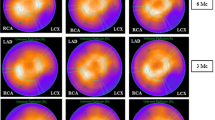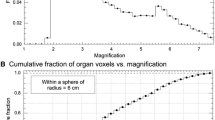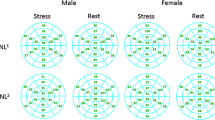Abstract
A database is an important factor in the statistical analysis of myocardial scintigraphy. Our aim in this study was to verify the validity of the threshold method using phantoms and to create a clinical database using this method. Since this method involves artificially excluding a low count area on a polar map, we created a myocardial phantom with defects. Then, we applied this method to the construction of a control database (CDB) for which we used stress–rest scans of 152 male and 52 female Japanese patients. The clinical relevance of this database was investigated by comparison of the values between the CDB and a Japanese normal database. In the study evaluation, we mainly used the summed extent score (SES) and a severity map (severity). Data from the phantom with defects demonstrated that the threshold method could compensate for defective areas, enabling the use of data for the creation of the CDB. Comparison of the CDB with the Japanese normal database showed a good relationship with respect to the SES and severity (Initial post-stress: SES: r = 0.978; severity: r = 0.997, Redistribution: SES: r = 0.944; severity: r = 0.993). The threshold method facilitates the effective creation of a database by use of clinical data. This enables individual institutions to build their own databases, taking into account differences in collection and processing conditions between institutions as well as the characteristics of individual equipment.






Similar content being viewed by others
References
Garcia EV, Train KV, Maddahi J, Prigent F, Friedman J, Areeda J, et al. Quantification of rotational thallium-201 myocardial tomography. J Nucl Med. 1985;26:17–26.
Lin GS, Hines HH, Grant G, Taylor K, Ryals C. Automated quantification of myocardial ischemia and wall motion defects by use of cardiac SPECT polar mapping and 4-dimensional surface rendering. J Nucl Med Technol. 2006;34:3–17.
Tamaki N. Guidelines for clinical use of cardiac nuclear medicine (JCS 2005). Circ J. 2005;69(Suppl.IV):1125–202.
Yamashina A. Guidelines for noninvasive diagnosis of coronary artery lesions (JCS 2009). Circ J. 2009;73(Suppl.III):1038–40.
Segall GM, Davis MJ, Goris ML. Improve specificity of prone versus supine thallium SPECT imaging. Clin Nucl Med. 1988;13:915–6.
Nakajima K, Kumita A, Ishida Y, Momose M, Hashimoto J, Morita K, et al. Creation and characterization of Japanese standards for myocardial perfusion SPECT: database from the Japanese Society of Nuclear Medicine Working Group. Ann Nucl Med. 2007;21:505–11.
Eisner RL, Tamas MJ, Cloninger K, Shonkoff D, Oates JA, Gober AM, et al. Normal SPECT thallium-201 bull’s-eye display: gender differences. J Nucl Med. 1988;29:1901–9.
Abufadel A, Eisner RL, Schafer W. Differences due to collimator blurring in cardiac images with use of circular and elliptic camera orbits. J Nucl Cardiol. 2001;8:458–65.
Liu YH, Lam PT, Sinusas AJ, Wackers FJT. Differential effect of 180° and 360° acquisition orbits on the accuracy of SPECT imaging: quantitative evaluation in phantoms. J Nucl Med. 2002;43:1115–24.
O’Connor MK, Hruska CB. Effect of tomographic orbit and type of rotation on apparent myocardial activity. Nucl Med Commun. 2005;26:25–30.
Heikkinen J, Ahonen A, Kuikka JT, Rautio P. Quality of myocardial perfusion single-photon emission tomography imaging: multicentre evaluation with a cardiac phantom. Eur J Nucl Med. 1999;26:1289–97.
Nakajima K, Okuda K, Kawano M, Matsuo S, Slomka P, Germano G, et al. The importance of population-specific normal database for quantification of myocardial ischemia: comparison between Japanese 360 and 180-degree databases and a US database. J Nucl Cardiol. 2009;16:422–30.
Nakajima K, Taki J, Yamamoto W, Michigishi T, Tonami N. Effect of 360° and 180° rotation SPET acquisitions on myocardial polar map: comparison of 201Tl-,99Tcm-and 123I-labelled radiopharmaceuticals. Nucl Med Commun. 1998;19:315–25.
Berman DS, Abidov A, Kang X, Hayes SW, Friedman JD, Sciammarella MG, et al. Prognostic validation of a 17-segment score derived from a 20-segment score for myocardial perfusion SPECT interpretation. J Nucl Cardiol. 2004;11:414–23.
Cerqueira MD, Weissman NJ, Dilsizian V, Jacobs AK, Kaul S, Laskey WK, et al. Standard myocardial segmentation and nomenclature for tomographic imaging of the heart: a statement for healthcare professionals from the Cardiac Imaging Committee of the Council on Clinical Cardiology of the American Heart Association. Circulation. 2002;105:539–42.
Yoshinaga K, Matsuki T, Hashimoto A, Tsukamoto K, Nakata T, Tamaki N. Validation of automated quantitation of myocardial perfusion and fatty acid metabolism abnormalities on SPECT images. Circ J. 2011;9:2187–95.
Ladenheim ML, Pollock BH, Rozanski A, Berman DS, Staniloff HM, Forrester JS, et al. Extent and severity of myocardial hypoperfusion as predictors of prognosis in patients with suspected coronary artery disease. J Am Coll Cardiol. 1986;7:464–71.
EI-Ali HH, Palmer J, Carlsson M, Edenbrandt L, Ljungberg M. Interdependence between measures of extent and severity of myocardial perfusion defects provided by automatic quantification programs. Nucl Med Commun. 2005;26:1125–30.
Maddahi J, Garcia EV, Berman DS, Waxman A, Swan HJC, Forrester J. Improved noninvasive assessment of coronary artery disease by quantitative analysis of regional stress myocardial distribution and washout of thallium-201. Circulation. 1981;64:924–35.
Slomka PJ, Nishina H, Berman DS, Akincioglu C, Abidov A, Friedman JD, et al. Automated quantification of myocardial perfusion SPECT using simplified normal limits. J Nucl Cardiol. 2005;12:66–77.
Udelson JE, Coleman PS, Metherall J, Pandian NG, Gomez AR, Griffith JL, et al. Predicting recovery of severe regional ventricular dysfunction. Comparison of resting scintigraphy with 201Tl and 99mTc-sestamibi. Circulation. 1994;89:2552–61.
Nakagawa S, Ishita Y. Myocardial scintigraphy master guide (Shinkin shinchi masterguide). Shindan to chiryousya, Tokyo, Japan; 2000. p. 30–31.
Germano G, Kavanagh PB, Berman DS. An automatic approach to the analysis, quantitation and review of perfusion and function from myocardial perfusion SPECT images. Int J Card Imaging. 1997;13:337–46.
Germano G, Kavanagh PB, Waechter P, Areeda J, Kriekinge SV, Sharir T, et al. A new algorithm for the quantitation of myocardial perfusion SPECT.: technical principles and reproducibility. J Nucl Med. 2000;41:712–9.
Nakajima K. Normal value for nuclear cardiology: Japanese databases for myocardial perfusion, fatty acid and sympathetic imaging and left ventricular function. Ann Nucl Med. 2010;24:125–35.
Takeishi K, Morishima T, Tsuneoka R, Kanzaki E, Fujiwara K, Fuse S, et al. Comparison with normal database (NDB) is important to objectively assess myocardial perfusion [in Japanese]. RINSHO HOSYASEN (Jpn J Clin Radiol). 2011; 56:87–101.
Berman DS, Kang X, Gransar H, Gerlach J, Friedman JD, Hayes SW, et al. Quantitative assessment of myocardial perfusion abnormality on SPECT myocardial perfusion imaging is more reproducible than expert visual analysis. J Nucl Cardiol. 2009;16:45–53.
Wolak A, Slomka PJ, Fish MB, Lorenzo S, Berman DS, Germano G. Quantitative diagnostic performance of myocardial perfusion SPECT with attenuation correction in women. J Nucl Med. 2008;49:915–22.
Bateman TM, Cullom SJ. Attenuation correction single-photon emission computed tomography myocardial perfusion imaging. Semin Nucl Med. 2005;35:37–51.
Conflict of interest
The authors declare that they have no conflict of interest.
Author information
Authors and Affiliations
Corresponding author
About this article
Cite this article
Narita, A., Shiomi, S., Kawabe, J. et al. Validation of threshold method for myocardial control database by use of clinical data. Radiol Phys Technol 7, 340–351 (2014). https://doi.org/10.1007/s12194-014-0271-4
Received:
Revised:
Accepted:
Published:
Issue Date:
DOI: https://doi.org/10.1007/s12194-014-0271-4




